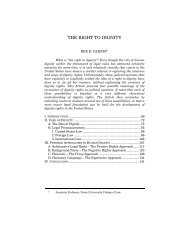A Right to Media? Lorie M. Graham - Columbia Law School
A Right to Media? Lorie M. Graham - Columbia Law School
A Right to Media? Lorie M. Graham - Columbia Law School
You also want an ePaper? Increase the reach of your titles
YUMPU automatically turns print PDFs into web optimized ePapers that Google loves.
2010] A RIGHT TO MEDIA? 457<br />
religious or linguistic minorities exist,” persons belonging <strong>to</strong> minority<br />
groups shall not be denied the right <strong>to</strong> enjoy their own culture or <strong>to</strong><br />
use their own language. 105 The Human <strong>Right</strong>s Committee (the<br />
“HRC”) elaborated upon the scope of state obligations under Article<br />
27 by stating that:<br />
The Committee concludes that article 27 relates <strong>to</strong> rights<br />
whose protection imposes specific obligations on States<br />
parties. The protection of these rights is directed <strong>to</strong>wards<br />
ensuring the survival and continued development of the<br />
cultural, religious and social identity of the minorities<br />
concerned, thus enriching the fabric of society as a<br />
whole . . . . 106<br />
The HRC has noted in particular that the language rights<br />
protected under Article 27 are “distinct from other language rights<br />
protected under the [ICCPR],” including “the general right <strong>to</strong><br />
freedom of expression protected under Article 19 [of the ICCPR].” 107<br />
This supports the recognition in Article 16 of the right of indigenous<br />
peoples <strong>to</strong> establish media in their own language.<br />
The Children’s Convention (the “CRC”) similarly links media<br />
rights with the right <strong>to</strong> cultural and linguistic integrity. As earlier<br />
noted, Articles 13 and 17 of the CRC require states <strong>to</strong> take steps <strong>to</strong><br />
promote cultural awareness and pluralism in media so as <strong>to</strong> benefit<br />
indigenous children, which in turn advances the cultural integrity<br />
rights of indigenous peoples, as children are the primary means by<br />
which those rights are carried forward. 108 Additionally, Articles 17<br />
and 30 of the CRC both recognize and advance the language rights of<br />
indigenous children through media and other means. 109 Since media,<br />
by its very nature, has the ability <strong>to</strong> promote language and cultural<br />
integrity, programming presented in indigenous languages and<br />
oriented from indigenous worldviews has the potential <strong>to</strong> bolster<br />
indigenous culture and revitalize threatened languages consistent<br />
with the mandates of Article 16 of the UNDRIP.<br />
105. ICCPR, supra note 36, art. 27. Although Article 27 of the ICCPR<br />
refers <strong>to</strong> “ethnic, linguistic and religious minorities,” the protections granted in<br />
the provisions apply <strong>to</strong> indigenous peoples as well. Human <strong>Right</strong>s Comm.,<br />
Compilation of General Comments and General Recommendations Adopted by<br />
Human <strong>Right</strong>s Treaty Bodies, general cmt. 23, paras. 3.2, 7, U.N. Doc.<br />
HRI/GEN/1/Rev.1 (July 29, 1994).<br />
106. Id. at general cmt. 23, para. 9.<br />
107. Id. at general cmt. 23, para. 5.3.<br />
108. Children’s Convention, supra note 39, arts. 13, 17.<br />
109. Children’s Convention, supra note 39, arts. 17, 30.















